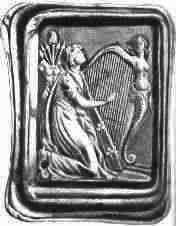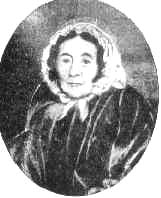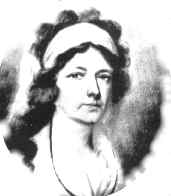Mary Helen Thuente, 'Liberty, Hibernia and Mary Le More' in Daire Keogh & Nicholas Furlong (eds.), The Women of 1798, Dublin, 1998, p.10.

The seal of the United Irishmen
National Museum of Ireland
The French Revolution and the American War of Independence inspired the United Irishmen in their rebellion in 1798 and many women took active parts in all three campaigns. The French slogan of 'Liberty, Equality and Fraternity' applied to men only however and most revolutionaries at that time did not favour equal rights for women.
|
The end of all political associations is the preservation of the natural and imprescriptible rights of man; and these rights are liberty, property, security and resistance to oppression. |
| We hold these truths to be self-evident, that all men are created equal, that they are endowed by their Creator with certain unalienable Rights, that among these are Life, Liberty, and the pursuit of Happiness. That to secure these rights, Governments are instituted among Men, deriving their just powers from the consent of the governed. U.S Declaration of Independence, 1776. |
The French revolutionaries used female figures to symbolise Reason, the Revolution itself and, ironically, even the concept of Equality.
A favourite symbol of the United Irishmen was the Maiden Harp.
| The maiden harp, with a forepillar of a winged figure who was a naked woman from the waist up and a fish from the waist down, had been used as a visual symbol of Ireland since the seventeenth century. The maiden harp was a popular United Irish motif, appearing on the United Irish seal and membership certificates, on the mastheads of two United Irish newspapers ... and as the insignia on Wolfe Tone's design for an Irish flag and Robert Emmet's design for a seal. Its exact meaning has been lost, but it is clearly connected with classical, medieval and Irish traditions.' Mary Helen Thuente, 'Liberty, Hibernia and Mary Le More' in Daire Keogh & Nicholas Furlong (eds.), The Women of 1798, Dublin, 1998, p.10. |
 The seal of the United Irishmen National Museum of Ireland |
In 1793, Mary Wollstonecraft encouraged discussion of women's rights in her book A vindication of the rights of woman which was read by an increasingly literate middle class. Amongst those who read one of several Irish editions of this book were Mary Ann McCracken and Martha McTier of Belfast whose correspondence with her brother William Drennan is an important source for the period.

Mary Ann McCracken |

Martha McTier |
Mary Ann McCracken (1770-1866) was born into a wealthy Presbyterian business family in Belfast. Sympathy with republican ideals spread to Ulster from America through Presbyterian emigration channels and many Presbyterians joined the United Irishmen although others were bitterly opposed. There was also a society of United Irish Women but Mary Anne did not altogether approve of separate organisations for women:
| ... as there can be no other reason for having them separate but keeping the women in the dark and certainly it is equally ungenerous and uncandid to make tools of them without confiding in them. Quoted by John Gray, 'Mary Ann McCracken' in Daire Keogh &: N. Furlong (eds.), The Women of 1798, Dublin, 1998, p.53. |
Mary Ann was intelligent and well-read and like her contemporary Mary Wollstonecraft was concerned about women's rights.
| There can be no argument produced in favour of the slavery of women that has not been used in favour of general slavery ... I therefore hope that it is reserved for the Irish nation to strike out something new and to shew an example of candour, generosity and justice superior to any that have gone before them. Letter of Mary Ann McCracken to her brother Henry Joy McCracken, 1797. P.R.O.N.I. |
Her brothers, William and Henry were imprisoned in Kilmainham Jail for their republican activities. She worked courageously for their release and attempted to arrange Henry's escape through Carrickfergus. When he was condemned to death she walked to the scaffold with him and tried to revive him after his execution.
Her strong opinions on Anglo-Irish politics - and marriage as it was then - were expressed on the occasion of the Act of Union, 1800.
| What a wonderful clamour is now raised at the name of the Union, when in reality there has always been such an union between England and this country, as there is between husband and wife by which the former has the power to oppress the latter. Quoted by John Gray, 'Mary Ann McCracken' in Daire Keogh & N. Furlong (eds.), The Women of 1798, Dublin, 1998, p.58. |
She did not, in fact ever marry. She ran a muslin business with her sister Margaret and later in life took an active part in the anti-slavery campaign and in local charities.
Matilda Tone née Martha Witherington (1769-1849), eloped with Theobald Wolfe Tone when she was sixteen years old and he persuaded her to change her name to Matilda for romantic reasons. Their marriage seems to have been a happy one.
| I recall with transport the happy days we spent during that period; the delicious dinners, in the preparation of which my wife, Russell [Thomas Russell, United Irishmen leader from Belfast] and myself were all engaged; the afternoon walks, the discussions we had, as we lay stretched on the grass ... My wife was the centre and the soul of all. I scarcely knew which of us loved her best; her courteous manners, her never-failing cheerfulness, her affection for me and for our children, rendered her the object of our common admiration and delight. W.T. Tone, Life of Theobald Wolfe Tone, Washington, 1926, p.35. |
While Tone was involved in dangerous revolutionary projects, Martha led an insecure life rearing their children in Ireland, America, France and Germany but she showed considerable courage and perseverance. Tone was captured in 1798 and died in prison from the effects of a self-inflicted wound.
| That Tone left the responsibility for his son's education to Matilda, generally the task of a close male friend or relative, shows his great confidence in her judgement and abilities, as well he should, for Matilda had consistently shown herself the most capable of women. Nancy J. Curtin, 'Matilda Tone' in Daire Keogh & N. Furlong (eds.), The Women of 1798, Dublin, 1998, p.40. |
Bridget 'Croppy Biddy' Dolan (1777-1827) has gone down in legend in Wicklow and Wexford as a rebel-turned-informer, and anti-heroine of 1798. Women might be involved in the rebellion in various ways: carrying information and supplies and even occasionally fighting in the ranks. Some women were prostitutes while others were afraid to stay in their own homes especially if they or their families were under suspicion. Biddy Dolan knew many leading rebels and for some reason joined them in their camps. The rebels dealt savagely with suspected informers:
| Tensions concerning Dolan may have been exacerbated by the heightened threat posed by informers during the later stages of the rebellion of whom many were women. Holt narrowly prevented his men from cutting the ears off a suspected female spy in late August and she was instead flogged with the cat-of-nine-tails.' Ruan O'Donnell, 'Bridget 'Croppy Biddy' Dolan' in Daire Keogh & N. Furlong (eds.), The Women of 1798, Dublin, 1998, p.101. |
When Biddy Dolan was arrested after the failure of the rebellion, she turned informer for the Crown and implicated her companions. Her evidence was considered unreliable however and an order went out that no one should be executed on the basis of her testimony alone. She was paid £22 from an informers' fund but seems to have lived in poverty, sometimes ridiculed but generally unharmed in Carnew until she died at the age of fifty.
Anne Devlin (1781-1851) was a native of Wicklow, a member of a rebel family and a cousin of the rebel leader Michael O'Dwyer. Anne was working in Robert Emmet's house while he plotted his 1803 insurrection. After it failed she was tortured by yeomen demanding information.
| The magistrate pressed her to tell the truth ... At length the magistrate gave the word to hang her, and she was dragged into the courtyard to be executed. There was a common car there - they tilted up the shafts and fixed a rope from the backband that goes across the shafts ... prodding her with their bayonets in the arms and shoulders till she was all covered with blood ... the rope was at length put about her neck ... she was suspended by the neck. After she had been thus suspended for two or three minutes her feet touched the ground, and a savage yell of laughter recalled her to her senses. The rope round her neck was loosened and her life was spared - she was let off with half-hanging. She was then sent to town and brought before Major Sirr. Helena Concannon, The women of '98, Dublin, 1919, p.287. |
Major Sirr offered her the substantial bribe of £500 which she refused. She was further tortured in Kilmainham Jail but in spite of her youth gave no information and languished in prison until 1806. She later married, lived in extreme poverty and when she died in 1851 was,
| ... still living in a miserable garret of No. 2 Little Elbow Lane, a squalid alley running from the Coombe to Pimlico .... She was very badly off, not only for food, but for bed-clothes. Nearly all the rags she had went at one time or another to get her a morsel of bread. Helena Concannon, The women of '98, Dublin, 1919, p.292. |
Her story was recorded by Brother Luke Cullen and by Dr. R.R. Madden, historian of the 1798 Rebellion.
Mary Leadbeater (1758-1826) was born into the Society of Friends or 'Quakers,' at Ballitore, Co. Kildare. She agreed with the rebels in resisting injustice and oppression but rejected violence in accordance with Quaker principles.
She kept a journal of her experiences during the years 1795-98. It records how troops were billeted in her home and in the other houses in the village and how they frequently searched for weapons. Some of her 'disloyal' correspondence could have got her into deep trouble when her family came under suspicion.
| Two small pieces of evidence suggest how most of her correspondence during this period disappeared. In the Annals of Ballitore she describes an incident in which her family narrowly escaped government reprisal through a stroke of luck. She had carelessly thrown 'one of the squibs then privately circulated, which in very tolerable poetry avowed disloyal sentiments' into her desk. The house was subsequently searched by a patrol seeking such evidence of disloyalty, but by a lucky accident it was not discovered. Mary's response was instantaneous: 'I started at the danger it was so near to bringing upon us, and thankfully flung it into the fire.' Kevin O'Neill 'Mary Shackleton Leadbeater' in Daire Keogh & N. Furlong (eds.), The Women of 1798, Dublin, 1998, p.157. |
She also recorded local arrests, interrogations, reprisals, burnings and floggings by the soldiers. Her village was held for three days by the rebels and subsequently retaken by the army who burned it and killed those under suspicion.